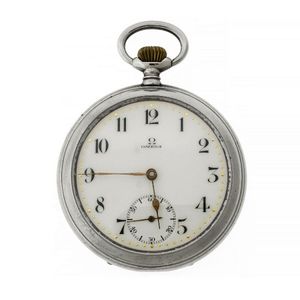Omega Pocket Watch, Guilloche Dial, 1912
You must be a subscriber, and be logged in to view price and dealer details.
Subscribe Now to view actual auction price for this item
When you subscribe, you have the option of setting the currency in which to display prices to $Au, $US, $NZ or Stg.
- Movement - The technical name for the workings of a clock or watch, and does not include the dial or case.
- Guilloche - A form of classical decoration consisting of a repeating ornament of interlacing curved bands, sometimes forming circles, and further decorated with rosettes or other flower forms.
The name is derived from the inventor, French engineer Guillot, who invented a mechanical method of inscribing fine repeating patterns on to metallic surfaces.
On enamelled items with guilloche decoration, the surface is firstly engraved with the repeating pattern, and then covered with several layers of enamel, each of which is fired.
Where the item has not been enamelled the form of decoration is usually called "engine turned". - Engine Turned - Engine turning is a decorative technique used on metal surfaces to create intricate curving or geometric pattern. The process involves cutting a series of lines into the surface of the metal using a rose engine or decoration lathe which rotates the metal as it cuts, allowing the operator to create a repeating pattern that covers the entire surface. The resulting surface has a shimmering, reflective quality that is often described as "engine turned." Where an engine turned item has been enamelled, the term used to describe the decoration is usually guilloche.
Engine turning was originally developed to decorate metal objects such as firearms, scientific instruments, and other metal objects that required precise and elegant design.
This item has been included into following indexes:
Visually similar items

A Rolex World War II Military open face pocket watch, white enamel dial marked Rolex, with Arabic numerals, blued hands, subsidiary seconds, 15 jewel three quarter plate movement signed Rolex cal. 548, screw down back marked G.S.T.P.(General Services trade

An Elgin sterling silver open face pocket watch, white dial with Arabic numerals, blued hands, subsidiary seconds on a plate movement with damaskeening, snap on case marked A.W.W.Co. Size 50.4 mm. C, 1918

Omega pocket watch. 18 jewel movement in nickle plated case with good enamel dial. Running, unserviced

A silver open faced split dial quarter repeater pocket watch, Volta dial. Swiss case marked 935 silver 32737, 15 jewels, silvered dial, Breguet numbers, crown wind, movement unmarked quarter repeater. Total weight: 73.2 grams
